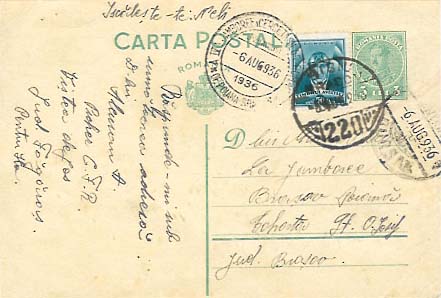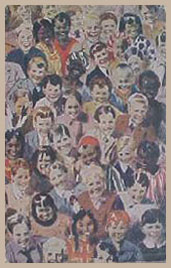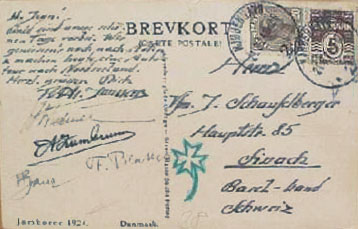|
I was most interested to read the Editor's report on the 1936 Romanian issue of stamps and their
cancellations. Peter asks when the three Scout stamps were issued. It has always been
 quoted as 20th August
1936 and this has been confirmed in my
copy of the Romanian National catalogue
of 1974 I understand that this is also the
date in the 1938 and 1948 catalogues, so
guess this must be correct. I also have a
cover with the stamps cancelled on 9th
August, and know of others with this date.
I have seen no other examples of the
Jamboree stamps being cancelled on cover
before 20th August. However the item on
piece shown in the last Bulletin is dated
13th August, as is a similar item in another
European Scout collection. Although the
postmark states the Jamboree was from 3rd
- 29th August, I am not really sure that the
actual Jamboree took place for that length
of time. The June 1936 issue of The
Scouter mentions that the UK contingent
would be leaving on 15th or 16th August
and return on 30th August. Our member
Fredy Scherb from Switzerland writing in our Bulletin in February 1974 states that "the Jamboree was
officially opened on August 10th by H.M. King Carol wearing Scout uniform". The cancel of 9th August on
covers with the Jamboree stamps were no doubt back dated as a favour by the postmaster. The postcard shown
above was postmarked on arrival at the camp with the Jamboree cancel dated 6th August.
quoted as 20th August
1936 and this has been confirmed in my
copy of the Romanian National catalogue
of 1974 I understand that this is also the
date in the 1938 and 1948 catalogues, so
guess this must be correct. I also have a
cover with the stamps cancelled on 9th
August, and know of others with this date.
I have seen no other examples of the
Jamboree stamps being cancelled on cover
before 20th August. However the item on
piece shown in the last Bulletin is dated
13th August, as is a similar item in another
European Scout collection. Although the
postmark states the Jamboree was from 3rd
- 29th August, I am not really sure that the
actual Jamboree took place for that length
of time. The June 1936 issue of The
Scouter mentions that the UK contingent
would be leaving on 15th or 16th August
and return on 30th August. Our member
Fredy Scherb from Switzerland writing in our Bulletin in February 1974 states that "the Jamboree was
officially opened on August 10th by H.M. King Carol wearing Scout uniform". The cancel of 9th August on
covers with the Jamboree stamps were no doubt back dated as a favour by the postmaster. The postcard shown
above was postmarked on arrival at the camp with the Jamboree cancel dated 6th August.
|
Please do not forget our Annual Exhibition being held at B.P. House on Saturday 21st February from
1030-1600 hours. Displays of Scout philatelic material will be on show and there will be a chance to
purchase items for your collection. It also gives you an opportunity to meet members of the committee.
|
I am always amazed at the prices sometimes obtained on Ebay, the web based auction house where you
can sell virtually anything. Over the last few weeks there have been a considerable number of postcards
offered by a person using the name "Yeppers ". These come from the late Claude Marchal's collection, as
can be seen by his four "M" badge (looking perhaps like a flower) which he insisted on adding and in my
opinion damaging many of the items that he purchased. This 1924 Jamboree card was postmarked
Copenhagen on 21st August 1924 and was described as a bit dog-eared. It showed in colour the faces of
young people from all over the world and was produced to sell at the Jamboree. The first bid was at $12.99
followed by four more bids up to $25 during the seven days it was on offer. It was only in
 the last 31 seconds that it had two more bids of $1,333 and $1,358 (about £755) through the "snipe"
system, which for a
small fee a company
the last 31 seconds that it had two more bids of $1,333 and $1,358 (about £755) through the "snipe"
system, which for a
small fee a company
 will electronically bid
on your behalf within
the last minute. This
also means you do not
have to stay up all
night! A postcard with
the 1920 purple cachet
made US$1031 (about
£617) and a 1929
registered Jamboree
card made $1675 (about
£1000 at the time).
will electronically bid
on your behalf within
the last minute. This
also means you do not
have to stay up all
night! A postcard with
the 1920 purple cachet
made US$1031 (about
£617) and a 1929
registered Jamboree
card made $1675 (about
£1000 at the time).
|



